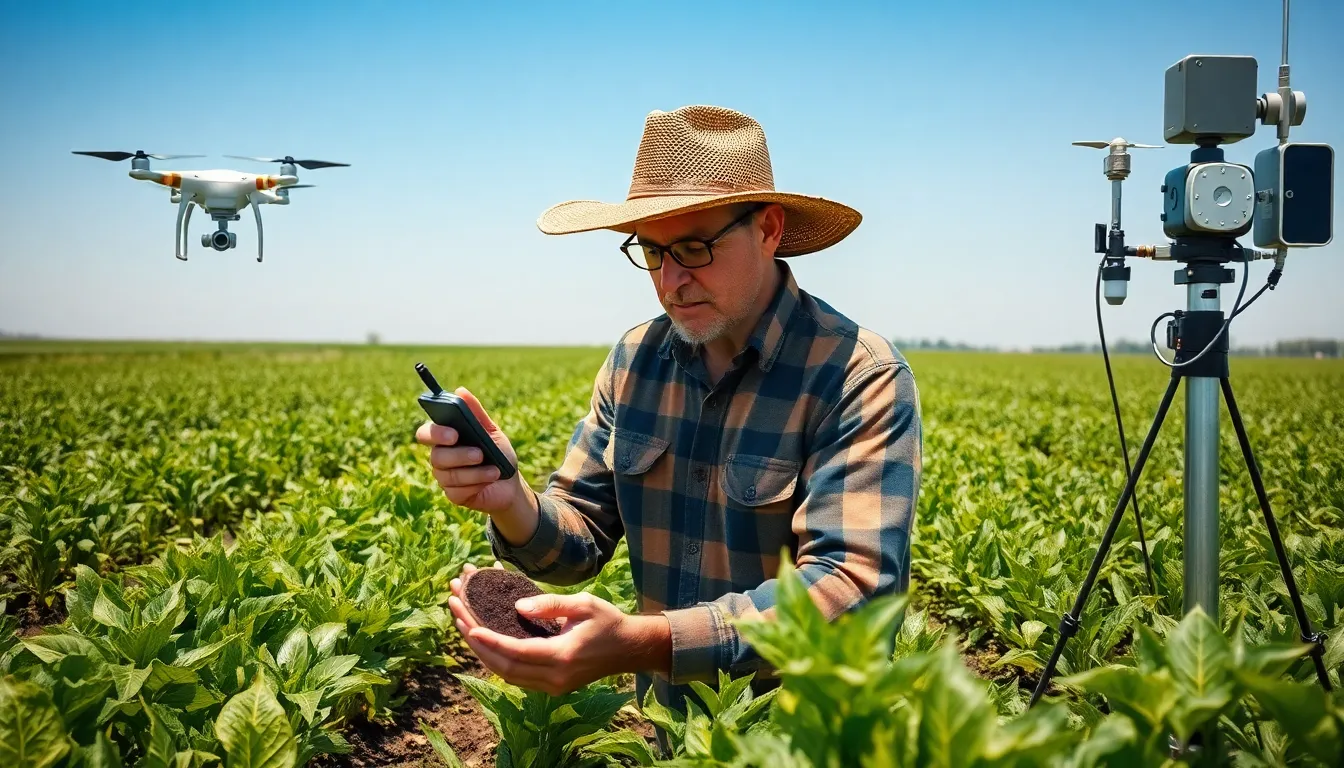In a world where even your fridge can text you when it’s running low on milk, smart farming IoT is the next big thing that’s ready to revolutionize agriculture. Imagine fields of crops chatting with sensors, sharing secrets about soil health and moisture levels like they’re gossiping at a coffee shop. This isn’t just a futuristic fantasy; it’s happening now, and it’s making farming more efficient and productive than ever.
Table of Contents
ToggleOverview of Smart Farming IoT
Smart farming utilizes IoT technology to enhance agricultural efficiency. Sensors placed throughout fields collect real-time data on soil conditions, moisture levels, and crop health, allowing farmers to make informed decisions. Crop management improves significantly through the analysis of this data.
Farmers can monitor environmental factors, including temperature and humidity, with ease. Automated irrigation systems react to sensor data, optimizing water usage based on specific crop needs. Drones play a crucial role by surveying land and identifying areas requiring attention.
Real-time analytics not only aid in resource management but also support predictive farming. By predicting weather patterns, farmers can plan planting schedules and harvest times. The integration of smart devices enables remote monitoring, providing flexibility for farmers to manage operations from any location.
Cost savings occur through improved efficiency. Reduced water consumption and optimized fertilizer usage lead to lower operational costs. With enhanced sustainability in mind, smart farming contributes to environmental protection by minimizing waste and conserving resources.
This transformation in agriculture is reflected in numerous case studies showcasing increased yields and profits. Adoption rates for IoT in agriculture rise steadily, highlighting its importance in modern farming practices. As technology develops, innovative solutions will continue to enhance productivity and sustainability in the sector.
Key Technologies in Smart Farming IoT
Smart farming IoT relies on several key technologies to enhance agricultural practices. These technologies include sensors, devices, and communication protocols that facilitate data collection and analysis.
Sensors and Devices
Sensors play a vital role in smart farming by gathering data on soil moisture, temperature, and nutrient levels. Installed in fields, devices monitor these parameters, offering real-time insights. Farmers can use this information to optimize irrigation systems, ensuring crops receive necessary water amounts. Various devices, including soil sensors, weather stations, and drones, collect data from different agricultural environments. This diversity in technology enables comprehensive monitoring of crop health, leading to smarter management decisions.
Communication Protocols
Communication protocols act as the backbone of smart farming IoT, facilitating data transfer between sensors, devices, and cloud platforms. Wi-Fi, LoRaWAN, and Zigbee represent some common protocols used to connect farm equipment. Reliable communication enables farmers to receive timely information, allowing for prompt actions based on real-time data. Compatibility between devices ensures seamless integration, which strengthens system efficiency. By leveraging these protocols, farmers enhance their ability to respond to environmental changes, ultimately improving crop yields and resource management.
Benefits of Smart Farming IoT
Smart farming IoT delivers multiple advantages that enhance agricultural practices. Modern technologies contribute significantly to efficiency and sustainability in farming operations.
Increased Efficiency
Real-time data collection optimizes crop management and irrigation. By using sensors, farmers can monitor soil conditions and moisture levels precisely. Drones assist by surveying large fields quickly, identifying areas needing attention. This automation reduces manual labor and allows for timely interventions. An integrated system maximizes resources like water and fertilizers, which lowers operational costs. Enhanced decision-making leads to improved yield potential and financial returns.
Sustainability and Environmental Impact
Smart farming IoT promotes eco-friendly practices while maximizing productivity. An emphasis on resource conservation minimizes waste and environmental strain. Sensors tailored for monitoring help farmers apply water and nutrients only where necessary. This precise application means reduced runoff and lower pollution levels in water systems. Sustainable practices contribute to healthier ecosystems while supporting resilient agricultural operations. As adoption increases, the environmental benefits grow, fostering a more sustainable future in agriculture.
Challenges Facing Smart Farming IoT
Smart farming IoT faces several challenges that could impact its effectiveness and adoption. Addressing issues such as data security and integration with existing systems is crucial for successful implementation.
Data Security and Privacy
Data security remains a significant concern in smart farming IoT. The transfer of sensitive information, including soil health and crop management data, increases the risk of cyberattacks. Farmers must ensure that robust encryption and security protocols are in place to protect data. Privacy issues may arise from sharing farm-related data, leading to potential misuse or unauthorized access. Regulations surrounding data protection must be adhered to, ensuring that farmers’ personal information remains confidential. Solutions like secure authentication methods and regular system updates can help mitigate these risks.
Integration with Existing Systems
Integrating smart farming IoT with legacy systems presents another challenge. Many farms rely on traditional methods and equipment, making seamless integration complex. Compatibility issues can hinder the deployment of new IoT solutions, leading to increased costs and operational disruptions. Implementing standardized protocols may facilitate smoother integration and reduce these challenges. Training personnel on new technologies is essential for maximizing efficiency. Collaborative efforts between technology providers and farmers can lead to tailored solutions that address specific integration needs.
Future Trends in Smart Farming IoT
Emerging trends in smart farming IoT indicate a shift towards increased automation and artificial intelligence integration. This integration empowers farmers to utilize machine learning algorithms for analyzing vast amounts of data collected from various sensors. Enhanced data analysis capabilities allow for more precise decision-making regarding crop management.
Advancements in drone technology support real-time monitoring and surveying. Drones equipped with high-resolution cameras provide insights into crop health and soil conditions, improving response times to issues. Additionally, the use of autonomous vehicles for planting and harvesting contributes to labor efficiency.
The role of blockchain technology in smart farming IoT cannot be overlooked. Transparency in the supply chain enhances traceability, ensuring that products meet quality standards. Greater consumer awareness drives demand for responsibly sourced agricultural products, making blockchain essential for compliance.
Integration of weather forecasting systems adds another layer of sophistication. By incorporating local weather data, farmers can better predict conditions affecting crop growth. This ability to anticipate weather patterns aids in scheduling planting and harvesting activities more effectively.
Investment in renewable energy sources like solar panels can further transform agricultural practices. Solar-powered IoT devices reduce dependency on external power sources, lowering overall operational costs. Adoption of renewable technologies aligns with global sustainability goals.
Collaboration between farmers and tech developers fosters innovation tailored to industry needs. Ongoing partnerships can lead to the creation of user-friendly applications and devices that cater to specific agricultural challenges. Prime opportunities for growth in smart farming IoT exist as technology continues to evolve and adapt to new agricultural demands.
Conclusion
Smart farming IoT represents a pivotal shift in agricultural practices. By harnessing real-time data and advanced technologies, farmers can optimize their operations and enhance sustainability. This innovative approach not only boosts productivity but also significantly reduces resource waste. As the adoption of smart farming continues to grow, the industry can expect even greater advancements in efficiency and environmental stewardship. Addressing challenges like data security and system integration will be crucial for maximizing the benefits of this technology. With ongoing collaboration between farmers and tech developers, the future of agriculture looks promising, paving the way for a more sustainable and productive farming landscape.





